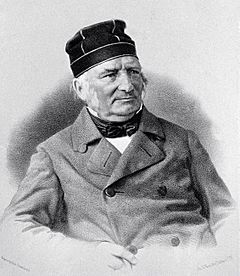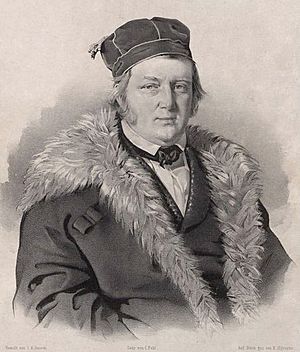Friedrich Georg Wilhelm von Struve facts for kids
Quick facts for kids
Friedrich Georg Wilhelm von Struve
|
|
|---|---|

Von Struve
|
|
| Born | 15 April 1793 Altona (today part of Hamburg), Duchy of Holstein
|
| Died | 23 November 1864 (aged 71) |
| Nationality | Baltic German |
| Citizenship | Danish, Russian |
| Alma mater | Imperial University of Dorpat |
| Awards | Gold Medal of the Royal Astronomical Society (1826) Royal Medal (1827) |
| Scientific career | |
| Fields | astronomy, geodesy |
Friedrich Georg Wilhelm von Struve (also known as Vasily Yakovlevich Struve in Russian) was a famous German and Russian astronomer and geodesist. He was born on April 15, 1793, and passed away on November 23, 1864. He is most famous for his studies of double stars and for starting a huge land survey called the Struve Geodetic Arc. This important project was later named after him.
Contents
Life and Early Studies
Friedrich Georg Wilhelm von Struve was born into the noble Struve family. His birthplace was Altona, which was then part of the Duchy of Holstein. This area is now part of Hamburg, Germany. His father was Jacob Struve.
In 1808, when Friedrich was 15, his family moved to the Russian Empire. They did this to avoid military service during the French occupation of Holstein. They used Danish passports to make the move.
He started studying at the University of Tartu (then called Dorpat) in 1808. At first, he studied languages. However, he soon became very interested in astronomy. From 1813 to 1820, he taught at the university. He also gathered important data at the Tartu Observatory.
In 1820, he became a full professor and the director of the observatory. His teaching had a lasting impact on the university.
Astronomical Discoveries and Honors
Struve spent many years researching double stars and working on geodesy (the science of measuring the Earth). He did this work in Dorpat until 1839. That year, he moved to St Petersburg and founded the new Pulkovo Observatory. He became its first director.
He received many awards for his work. In 1826, he won the Gold Medal of the Royal Astronomical Society. He was also chosen as a member of the Royal Society in 1827. The Royal Society also gave him their Royal Medal in the same year.
In 1833, he became a member of the Royal Swedish Academy of Sciences. The next year, he was made an honorary member of the American Academy of Arts and Sciences. In 1843, he officially became a Russian citizen. He retired in 1862 because his health was failing.
Legacy in Space
An asteroid called 768 Struveana was named after him. It also honors his son, Otto Wilhelm von Struve, and his grandson, Karl Hermann Struve.
A crater on the Moon was also named after three astronomers from the Struve family. These were Friedrich Georg Wilhelm, Otto Wilhelm, and Otto Struve.
Key Works and Contributions
Struve is most famous for his many years of observing double stars. These are two stars that appear close together in the sky. Sometimes they orbit each other.
Other astronomers like William Herschel had studied double stars before. But Struve did more work than anyone else. He found a very large number of new double stars.
In 1827, he published a catalog of these stars. It was called Catalogus novus stellarum duplicium. Stars from his catalog are sometimes marked with the Greek letter sigma (Σ). For example, the star 61 Cygni is also known as Σ2758.
Most double stars are true binary stars. This means they orbit around a common center point. Because of this, their positions slowly change over time. Struve carefully measured 2714 double stars between 1824 and 1837. He published these measurements in his book Stellarum duplicium et multiplicium mensurae micrometricae.
In 1843, Struve also carefully measured the "constant of aberration". This is a small shift in the apparent position of stars due to Earth's motion. He was also the first to measure the parallax of the star Vega. Parallax is how much a star seems to shift when viewed from different points in Earth's orbit. This helps astronomers figure out how far away stars are.
In 1847, Struve wrote a book called Etudes d'Astronomie Stellaire. In it, he was one of the first astronomers to notice the effects of interstellar extinction. This is when dust and gas between stars block some of their light. His estimate of how much light was blocked was very close to what modern scientists have found.
He was also very interested in geodetic surveying. This is the science of measuring the Earth's shape and size. In 1831, he published a book about measuring latitudes in Russia.
He started the Struve Geodetic Arc. This was a long chain of survey points. It stretched over 2,820 kilometers (about 1,750 miles). It went from Hammerfest in Norway all the way to the Black Sea. It passed through ten different countries. The goal was to find the exact size and shape of the earth. In 2005, UNESCO listed this chain as a World Heritage Site.
In 1853, he was chosen as a member of the American Philosophical Society.
The Struve Family of Scientists
Friedrich Struve was the start of a family of astronomers that lasted for five generations. He was the great-grandfather of Otto Struve. He was also the father of Otto Wilhelm von Struve, who became a famous astronomer too.
In 1815, he married Emilie Wall. They had 12 children, and 8 of them lived past early childhood. Besides Otto Wilhelm von Struve, another son was Heinrich Wilhelm von Struve. He became a well-known chemist. His son Bernhard Wilhelm von Struve worked for the government in Siberia.
After Emilie passed away, Friedrich married Johanna Henriette Francisca Bartels. She was the daughter of a mathematician named Martin Bartels. They had six more children. One of their most famous sons was Karl de Struve. He became a Russian ambassador to countries like Japan and the United States.
Bernhard's son, Pyotr Struve, was a very important person in Russia. He was one of the first Russian Marxists. He even wrote the first statement for the Russian Social Democratic Labour Party in 1898. Later, he joined a different political party that supported more liberal ideas. He was a member of the Russian parliament before the Russian Revolution. After the revolution, he joined the White movement, which fought against the new government. He lived in Paris for many years after that.
See also
 In Spanish: Friedrich Georg Wilhelm von Struve para niños
In Spanish: Friedrich Georg Wilhelm von Struve para niños
- List of Russian astronomers and astrophysicists


